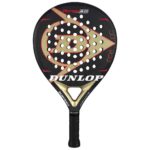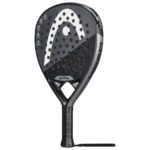Should I buy a padel racket produced by a famous company or a cheaper one produced by an unknown brand? What is the ideal weight? Should I buy a heavy, medium or light racket? How about the materials, shape and thickness of the racket? These are some of the reasonable questions you would ask yourself every time you buy a padel racket.
Below you can find some tips that will help you choose your next padel racket.
The Shape of your Padel Racket
Until not too long ago, there were only three shapes of rackets available. And you may still find some articles on the internet that classify rackets according to these criteria. But reality is different. As padel grows, producers of padel rackets continue to invest and innovate. The result is that nowadays you can find plenty of “hybrids”. Continue reading to learn the advantages of the three classic shapes plus the hybrids.
Round


Diamond


Tear Drop


Hybrids


The weight of your Racket
Most rackets range between 365gr. to 396gr. A light racket would be between 365gr and 375gr. A heavy racket would range 385gr to 395gr. Lighter rackets are better suited for beginners. kids and ladies. They are easier to handle. Heavier rackets are tougher to accelerate but they can provide extra power and solidity.
Thickness of the your Racket
Nowadays most rackets range between 36mm and 38mm. Thinner rackets are suitable for kids, ladies or beginners. Advanced players are advised to play with thicker rackets. In the past we had rackets as thin as 10mm or as thick as 40mm. Remember that the maximum thickness, for competition and tournaments, is 38mm.
Grip
No special considerations here. In contrast to other rackets sports, all Padel brands are currently implementing a “one grip only” policy. This means that there are no options available in regard to the thickness of the grip.
The good news is that most brands are manufacturing padel rackets featuring thin grips. This means that you can make as thick as you wish. Now, to the following question, what is the correct thickness of your grip and how do you make it thicker?
Size Does Matter


Simple. Grab a padel racket as if you were going to use it -continental grip or simply hold it as a hammer. Close your hand. The correct thickness of the grip is one that would not allow the tip of your middle finger to touch the other side of your hand. More precisely, the distance between your middle finger and the other side of your hand should be more or less one centimeter -or its equivalent: one finger-. More than that would be excessive, less than that, is not enough. This is an important consideration to avoid too much or too little tension on your hand and forearm, and thus, avoid injuries, such as the dreaded tennis elbow.
If your grip is not big enough, you can make it bigger by adding some cover-grips to it. How many? As many as necessary -sometimes even up to three- to make the grip thicker.
Would you like to buy a grip or two? Try at this store. They have plenty of options and decent prices.
Materials of your Padel Racket
Until few years ago, rackets where made of combinations of steel, iron, wood, rubber and aluminum. Today things have changed. There are plenty of other materials.
A racket has two main parts: the frame and the face. With regards to the frame, most of the rackets are nowadays made by a mix of fiberglass and carbon. Fiberglass is a cheaper material, but it is not strong. Most higher end rackets utilize some mix of carbon, graphite, graphene, kevlar or even titanium.
The core of the racket is typically made of a FOAM or E.V.A. Foam is a softer material. When the face is made of FOAM the racket will operate like a catapult. This is great for players that want to hit the ball hard without making much effort. The disadvantage is that you will loose control. E.V.A is a much harder material. It facilitates control and it is suitable for heavy hitters.
In addition, the face of the racket may also include kevlar, carbon or graphene to increase its durability.
Rugged face or not?
As you probably know, padel rackets have no strings. One of the results of this is that a padel racket is easy to handle. However, there lies a disadvantage as well. There is very little grip between the ball and the face of the racket.
Why is this important?
Most of the basic shots in padel are played plain, or in other words, without much slice or topspin. However, if you are an intermediate or advanced player, you will sometimes want to play some top spin or slice. A padel racket with a rugged face facilitates the grip between the ball and the racket. It facilitates the use of top spin and slice.
Check out for example the StarVie Methaora, with rugged face.
Best Brands
There are today over one hundred and fifty brands of rackets, produced by not more than fifteen producers. Thus, think well what you will buy. In some cases, you may pay higher prices simply because it has a known brand printed on the face. Some of the best known brands of Padel rackets are Dunlop, Varlion, Bullpadel, Wilson, Babolat and Head. You can find these and more rackets at SmashInn. It is a nice international store located in Barcelona, Spain. They offer a great variety of rackets and great service. Try it out. If you make use of this discount code TRADEBELB3 they will give you an extra 3% discount.
Conclusions
Beginners: Use a light to medium weight racket, preferably round and thin, 36mm or 38mm.
Medium level players: Use a medium weight racket. Use a round or tear shape racket, 36mm or 38mm.
Advanced players: Use any shape or weight. Most players will make the most of their talent by utilizing diamond shaped, heavier rackets, 38mm thick. If you like control and creative play, buy a round racket.
Ladies: lighter rackets are best for women. Most brands usually offer rackets specially tailored for women.
Kids: use a much lighter, thinner and smaller racket. Look for specially designed rackets for kids.
How about Padel Balls?
Yes, if you want to play a nice padel match, a good padel racket is not enough. Playing with good Padel balls is a must. And let’s insist “Padel” balls. Playing Padel with tennis balls is a big no no. Would you like to know why? Great, read this article: Is a Padel ball the same as a tennis ball?




![BASFc_wh52-5trdg_4c [Konvertiert]](https://www.padelcentrum.nl/wp-content/uploads/2018/07/gravity_home-1-640x429.jpg)










